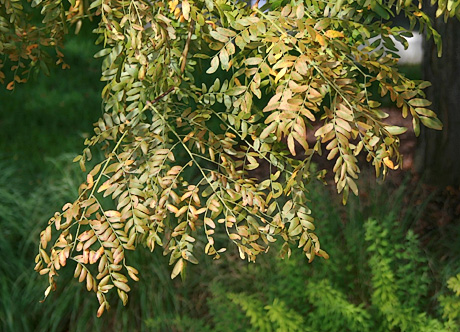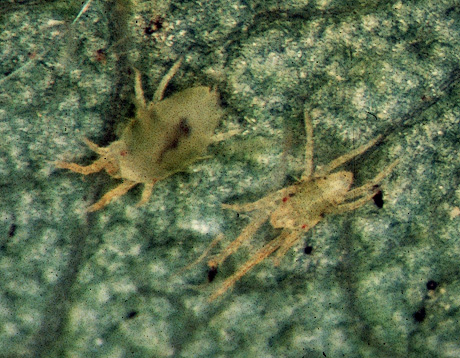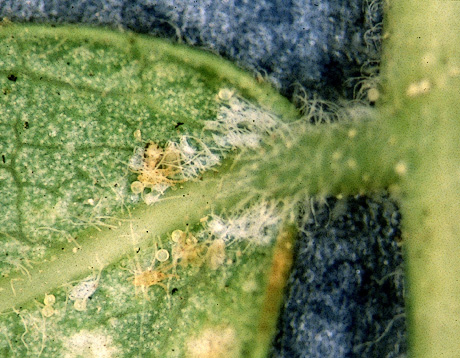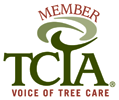
Honeylocust Spider Mite
Damage caused by the honeylocust spider mite
Honeylocust spider mites are common on honeylocust trees. They feed by sucking sap from the leaves, damaging leaf cells and causing small light flecks on the leaf. Heavy infestations can turn the entire leaf brown or gray and cause it to fall off. They usually cause little damage to tree, but can make it look unpleasant, and heavy infestations may stunt tree growth and cause twig dieback.
 Whitney Cranshaw, Colorado State University, Bugwood.org
Whitney Cranshaw, Colorado State University, Bugwood.org
How to identify the honeylocust spider mite
Honeylocust spider mites are not insects, they are arachnids, more closely related to spiders. They feed on the underside of leaves along the main vein.
Look for premature leaf browning and drop, webbing and remains of hatched eggs on underside of leaves. Shake infested leaves over white paper and look for tiny colored spots.
Their eggs are round. Adult honeylocust spider mites are barely visible to the naked eye. They have eight legs and a round body. They change color from yellow green in the summer, to orange in late summer and bright orange when overwintering. The honeylocust spider mite nymphs look like smaller versions of the adults, even tinier spots.
 Whitney Cranshaw, Colorado State University, Bugwood.org
Whitney Cranshaw, Colorado State University, Bugwood.org
Life cycle of the honeylocust spider mite
Adult female honeylocust spider mites overwinter in protected areas like cracks in the bark or under debris. They become active in late spring, eating, mating and laying about 12 eggs each day for a couple weeks.
Nymphs hatch from the eggs, feed on the leaf, molt twice and become an adult honeylocust spider mite 8-17 days later, depending on the weather. The large number of generations per season allows the population to grow very quickly during the summer.
In late summer the adult female honeylocust spider mites congregate around buds and in cracks in the bark to overwinter
 Whitney Cranshaw, Colorado State University, Bugwood.org
Whitney Cranshaw, Colorado State University, Bugwood.org
How to control the honeylocust spider mite
Lady beetles, minute pirate bugs, big-eyed bugs, predatory bugs, mites and thrips are natural predators of honeylocust spider mite. Be careful with insecticdes to prevent killing off them off, as they will keep the honeylocust spider mites under control. The honeylocust spider mites like dry conditions, and regular watering will reduce their numbers. Water sprayed on the honeylocust spider mites can knock them off the tree and kill them, and insecticidal soaps are effective control too. When miticide use is required to control the honeylocust spider mites, spray both the trunk and crown of the honeylocust tree because the mites overwinter in both places. We offer systemic controls for this pest that will cover all the life cycles with one treatment. Contact us to schedule a review of your locust to determine if a treatment is needed.
 Whitney Cranshaw, Colorado State University, Bugwood.org
Whitney Cranshaw, Colorado State University, Bugwood.org
Other resources





